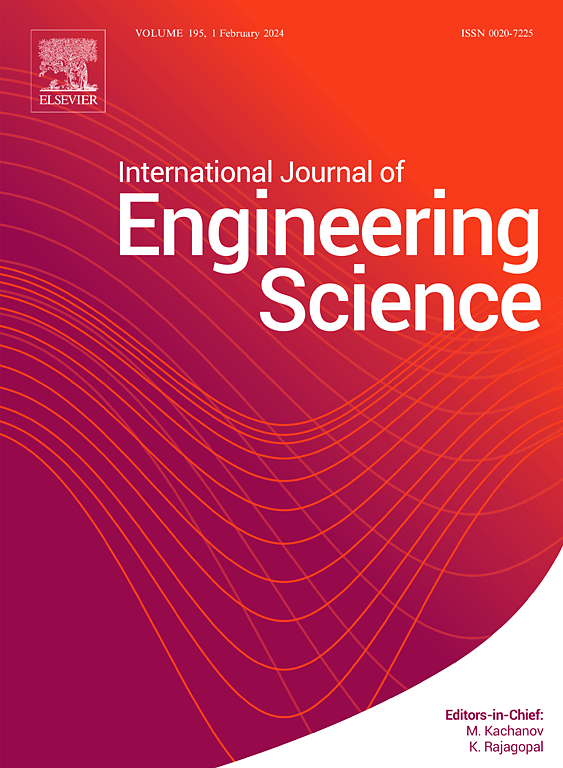椭球形夹杂微观几何的有效场方法与有限元模型。理论与应用
IF 5.7
1区 工程技术
Q1 ENGINEERING, MULTIDISCIPLINARY
International Journal of Engineering Science
Pub Date : 2025-09-11
DOI:10.1016/j.ijengsci.2025.104373
引用次数: 0
摘要
本研究比较了采用椭球体夹杂物的解析模型和数值模型的预测结果,以确定复合材料的有效性能。研究了影响均质精度的三组因素:均质化问题的类型(弹性、膨胀和电导率)、材料相特性(各向同性、夹杂取向和夹杂长宽比)以及建模方法,其中有效的场方法(efm) -包括非相互作用、Mori-Tanaka和Maxwell方法-在参数化研究中对伪颗粒分解方法(PGDM)和数值有限元(FE)模型进行了评估。研究考虑椭球状包裹体,其纵横比为0.2 ~ 5,取向散射从完全随机到完全排列。结果表明,均匀化问题的类型对efm的预测精度没有显著影响,Mori-Tanaka和Maxwell方法在所有性质上都与有限元模型具有很好的一致性。对于长径比大于1的复合材料,PGDM仅对某些弹性性能(例如E11)产生可靠的结果。因此,Mori-Tanaka和Maxwell方法是计算密集型有限元模型的最合适的分析选择。本文章由计算机程序翻译,如有差异,请以英文原文为准。
Effective field methods vs finite element models for microgeometries with ellipsoidal inclusions. Theory and application
This study compares the predictions of analytical and numerical models employing ellipsoidal inclusions to determine the effective properties of composite materials. Three groups of factors influencing homogenization accuracy are investigated: the type of homogenization problem (elasticity, expansion, and conductivity), the material phase characteristics (isotropy, inclusion orientation, and inclusion aspect ratio), and the modeling methodologies, where effective field methods (EFMs) – including the Non-Interaction, the Mori–Tanaka and Maxwell methods – are evaluated against the pseudo grain decomposition method (PGDM) and numerical finite element (FE) models in a parametric study. The study considers ellipsoidal inclusions with aspect ratios ranging from 0.2 to 5 and orientation scattering from completely random to fully aligned. The results indicate that the type of homogenization problem does not significantly affect the prediction accuracy of EFMs and that the Mori–Tanaka and Maxwell methods show excellent agreement with FE models for all properties. The PGDM is shown to yield reliable results only for certain elastic properties (e.g., ) for composites with inclusions of aspect ratios greater than 1. Therefore, it is concluded that the Mori–Tanaka and the Maxwell methods serve as the most suitable analytical alternatives to computationally intensive FE models.
求助全文
通过发布文献求助,成功后即可免费获取论文全文。
去求助
来源期刊

International Journal of Engineering Science
工程技术-工程:综合
CiteScore
11.80
自引率
16.70%
发文量
86
审稿时长
45 days
期刊介绍:
The International Journal of Engineering Science is not limited to a specific aspect of science and engineering but is instead devoted to a wide range of subfields in the engineering sciences. While it encourages a broad spectrum of contribution in the engineering sciences, its core interest lies in issues concerning material modeling and response. Articles of interdisciplinary nature are particularly welcome.
The primary goal of the new editors is to maintain high quality of publications. There will be a commitment to expediting the time taken for the publication of the papers. The articles that are sent for reviews will have names of the authors deleted with a view towards enhancing the objectivity and fairness of the review process.
Articles that are devoted to the purely mathematical aspects without a discussion of the physical implications of the results or the consideration of specific examples are discouraged. Articles concerning material science should not be limited merely to a description and recording of observations but should contain theoretical or quantitative discussion of the results.
 求助内容:
求助内容: 应助结果提醒方式:
应助结果提醒方式:


